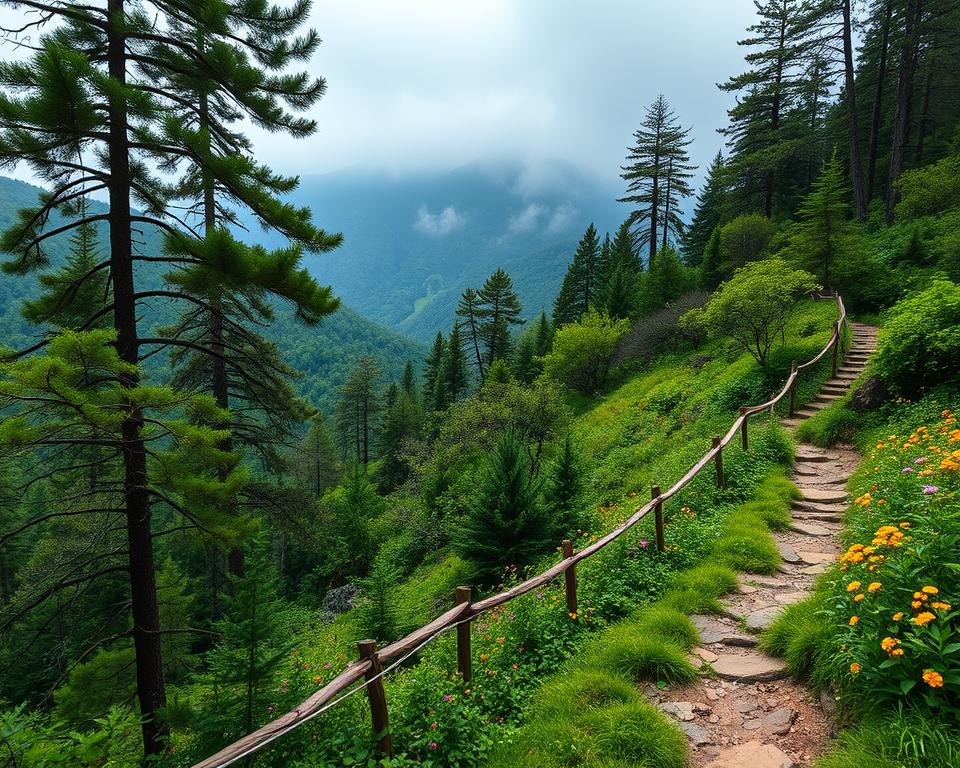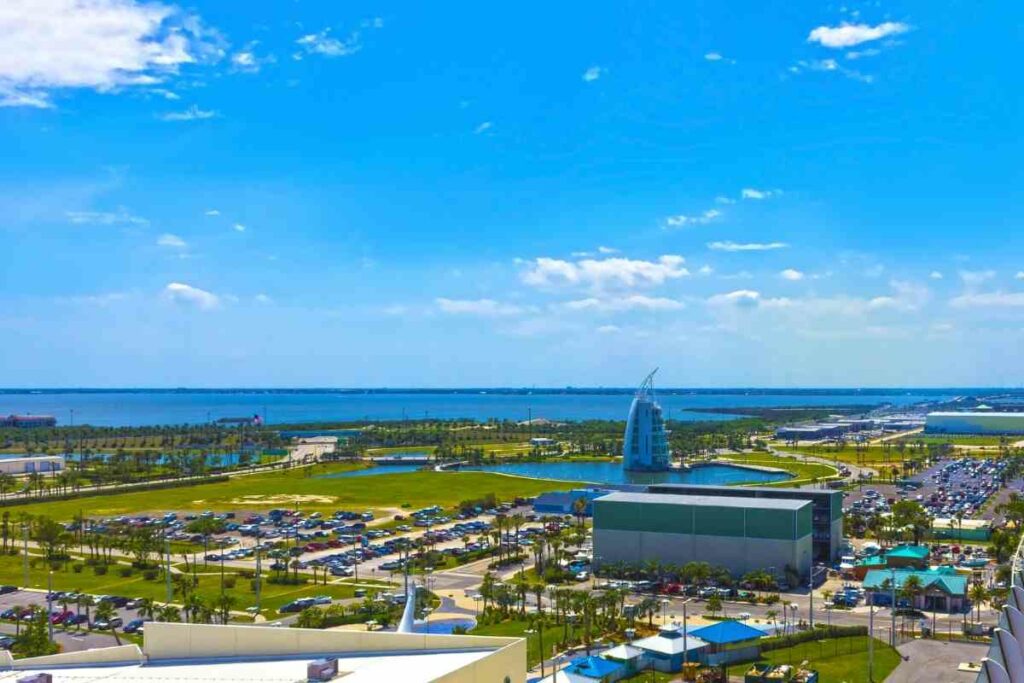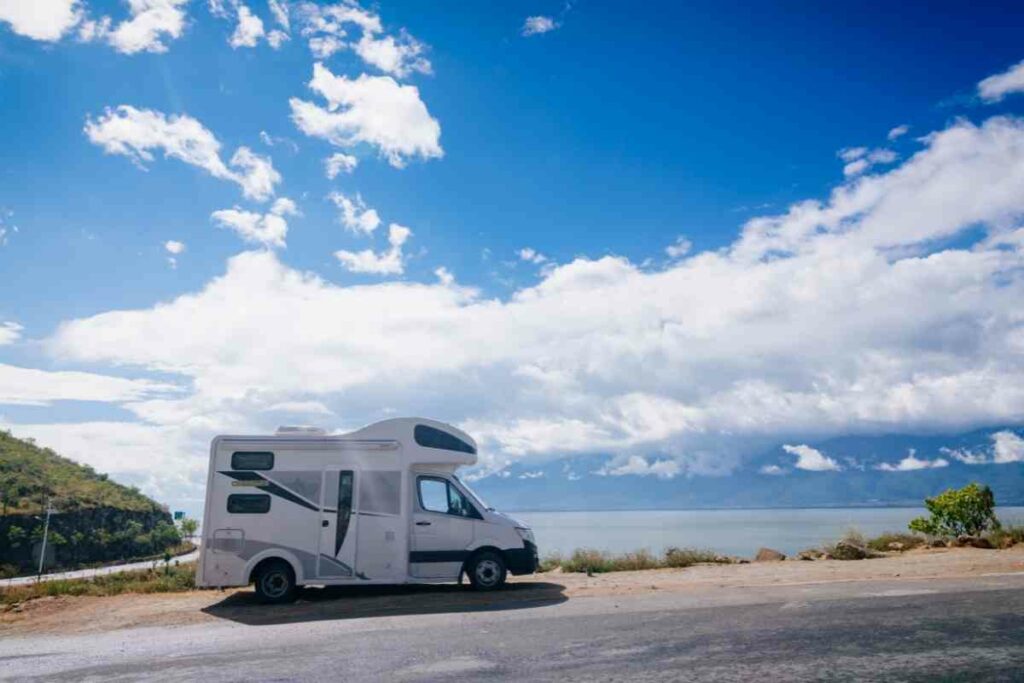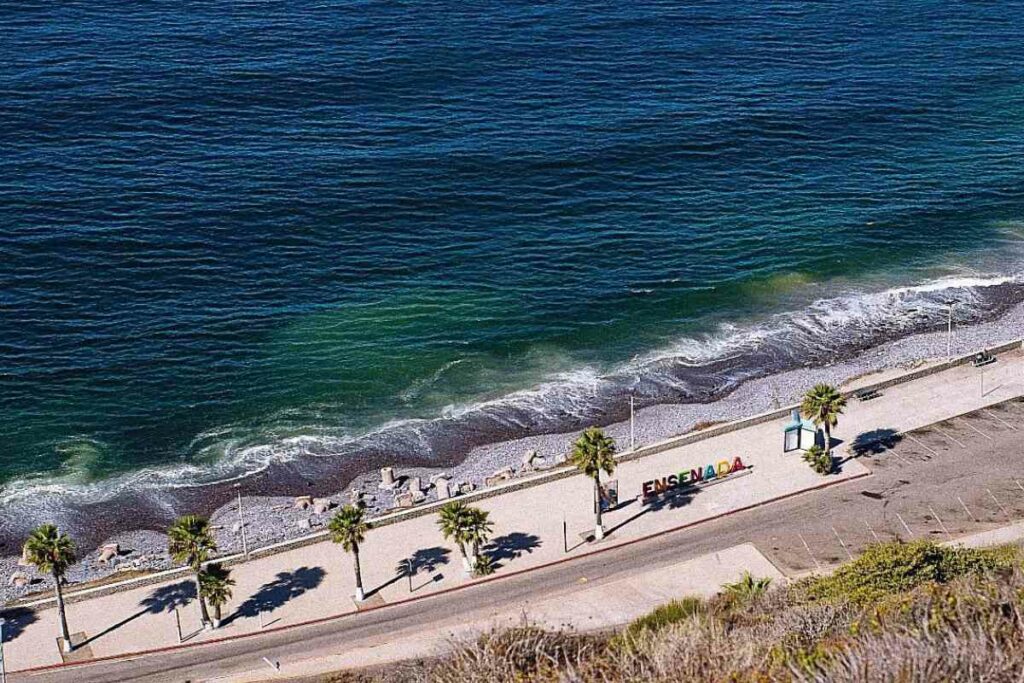A road trip from Yosemite to the Grand Canyon is an incredible journey that will take your breath away.
Along the way, you will pass through some of the most picturesque landscapes in the American Southwest.
The road trip can take approximately three days, depending on your desired stops and activities.
How Is The Route From Yosemite To Grand Canyon?
The direct drive from Yosemite to Grand Canyon is 692 mi (1113 km) and takes just over 12.5 hours.
The route travels through the states of California, Nevada, Arizona, and Utah, taking travelers through some of the most iconic attractions in the western United States.
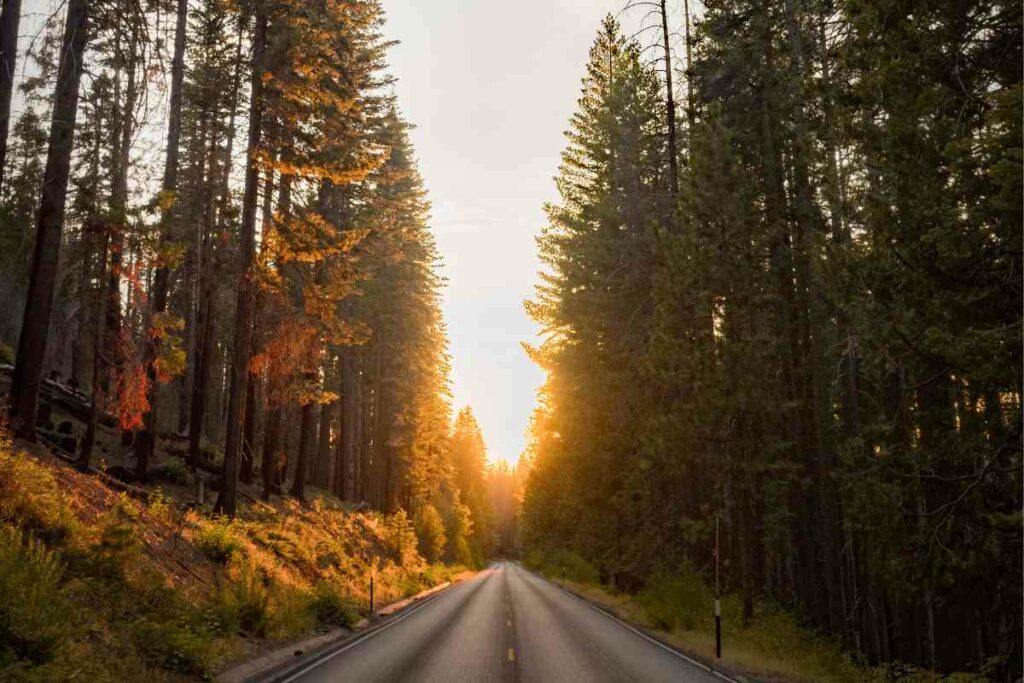
The journey is long, but it is worth it for the incredible views and experiences to be had.
Tips for an Enjoyable Journey:
- Allow plenty of time for the journey, as there are many sights and activities along the way.
- Be prepared for any weather, as temperatures can vary greatly.
- Bring plenty of water and snacks, as some areas can be remote.
- Bring a map of the region with you because mobile phone service might be patchy in certain places.
- Plan your route ahead of time and include pit stops and opportunities to stretch your legs.
- Make sure to bring a spare tire, always drive safely and obey the speed limit.
- Most importantly, don’t forget to have fun and enjoy the journey!
Sample Itinerary For A Drive From Yosemite To Grand Canyon National Park.
Along the way, you’ll experience some of the most stunning natural wonders and roadside attractions in the United States.
This includes towering mountain peaks, dramatic desert landscapes, quaint towns, and vibrant cities.
1. From Yosemite Drive through Yosemite National Park
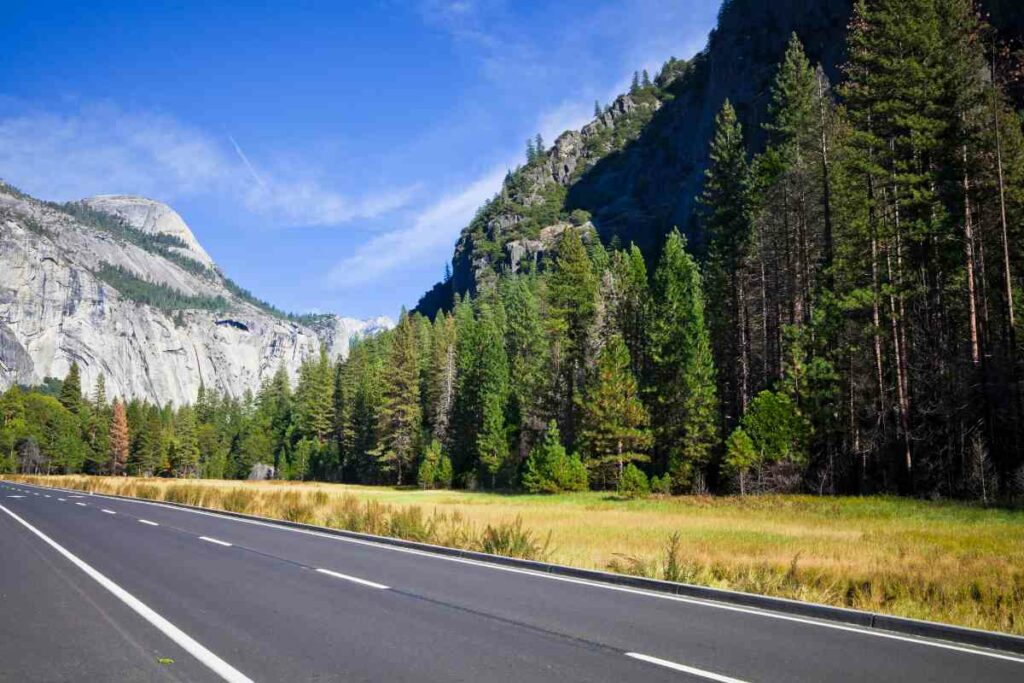
- Distance: Approximately 97 miles
- Time: Approximately 2 hours and 30 minutes
Getting to Yosemite National Park
To start your journey through Yosemite National Park, follow this route:
- Take Highway 140 to Mariposa.
- Turn onto Highway 49 and continue southbound for about 17 miles until you reach the small town of Coulterville.
- At Coulterville, take Highway 132 eastbound.
- Follow Highway 132 for about 24 miles until you reach the town of Groveland.
- Turn onto Highway 120 and head eastbound.
- Follow Highway 120 for about 40 miles until you reach the turnoff for Tioga Pass.
- Take the Tioga Pass turnoff and follow the road for another 12 miles until you reach the Yosemite National Park entrance.
Exploring Yosemite National Park
Yosemite National Park is one of the oldest and most famous national parks in the United States.
The park has some of the world’s most beautiful sceneries, including Half Dome, El Capitan, and Yosemite Falls.
It is also home to an incredible array of wildlife, including deer, bears, mountain lions, and many species of birds.
There are also a variety of activities available to visitors, such as:
- Camping
- Hiking
- Fishing
- Rock climbing
- Horseback riding
- Sightseeing
- There are also several museums and ranger-led programs that provide insight into the ecology and history of the area.
There are several trails to choose from, ranging from easy to complex. Popular trails include Four Mile Trail, Mist Trail, and Yosemite Falls Trail.
Camping and Lodging In Yosemite National Park
If you’re looking to stay overnight, there are various camping and lodging options available in Yosemite National Park.
Camping is available in both established campgrounds and wilderness areas.
Popular campgrounds include Upper Pines, Wawona, and Tuolumne Meadows.
For those looking for a more luxurious experience, several lodges and hotels are located in the park.
The Ahwahnee Hotel and Yosemite Lodge at the Falls are two of the most popular options.
2. Yosemite National Park to Sequoia National Park
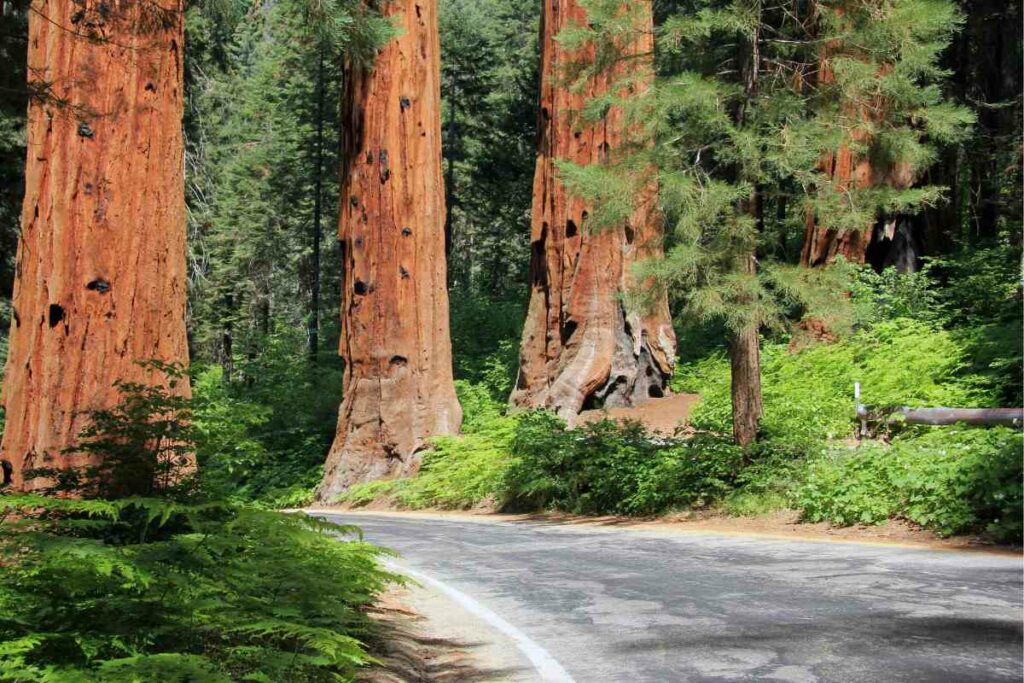
- Distance: Approximately 138 miles
- Time: Approximately 2 hours and 33 minutes
Getting to Sequoia National Park
- Start by driving south on CA-41 from Yosemite National Park.
- Follow the signs for Sequoia National Park from CA-41 and continue on the highway for approximately 90 miles.
- Once you reach the small town of Fish Camp, take the turnoff for Wawona Road.
- Follow Wawona Road for about 8 miles until you reach the turnoff for CA-41.
- Take the right turn onto CA-41 and drive for another 9 miles until you reach the entrance of Sequoia National Park.
Exploring Sequoia National Park
Sequoia National Park is a stunning park located in California’s Sierra Nevada mountain range.
It has some of the most impressive and largest trees in the world, and it is a great place to explore and appreciate the beauty of nature.
The park has more than 800 miles of trails for hikers and backpackers.
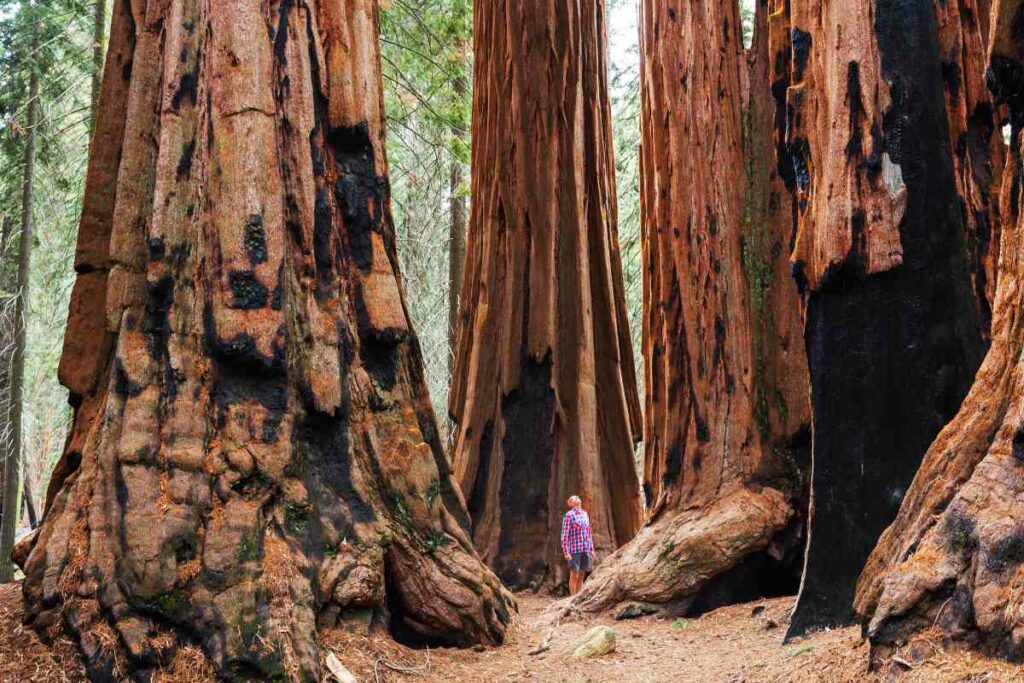
Trails range from short and easy day hikes to multi-day treks across the rugged terrain.
Even Better – The park also gives you a chance to experience the most amazing views of the Great Western Divide and the Sierra Nevada mountain range.
One of the park’s highlights is the General Sherman Tree, the largest living single-stem tree in the world.
There are several caves in the park, including the Crystal Cave and the Boyden Cavern, which are open to the public.
Visitors can also enjoy various activities like fishing, boating, and horseback riding. There are also several small towns nearby that offer a variety of restaurants and shops.
Camping and lodging
Visitors can enjoy camping in the park. There are 12 campgrounds in the park that offer amazing views.
Most of these campsites are within walking distance of trails and other attractions, making it easy to explore the park.
Accommodations range from rustic cabins to modern hotels.
The Wuksachi Lodge is a popular option, with its beautiful mountain views, comfortable rooms, and proximity to the park’s attractions.
Other lodging options include the Stony Creek Lodge, the High Sierra Camps, and the John Muir Lodge.
3. Sequoia National Park to Death Valley National Park
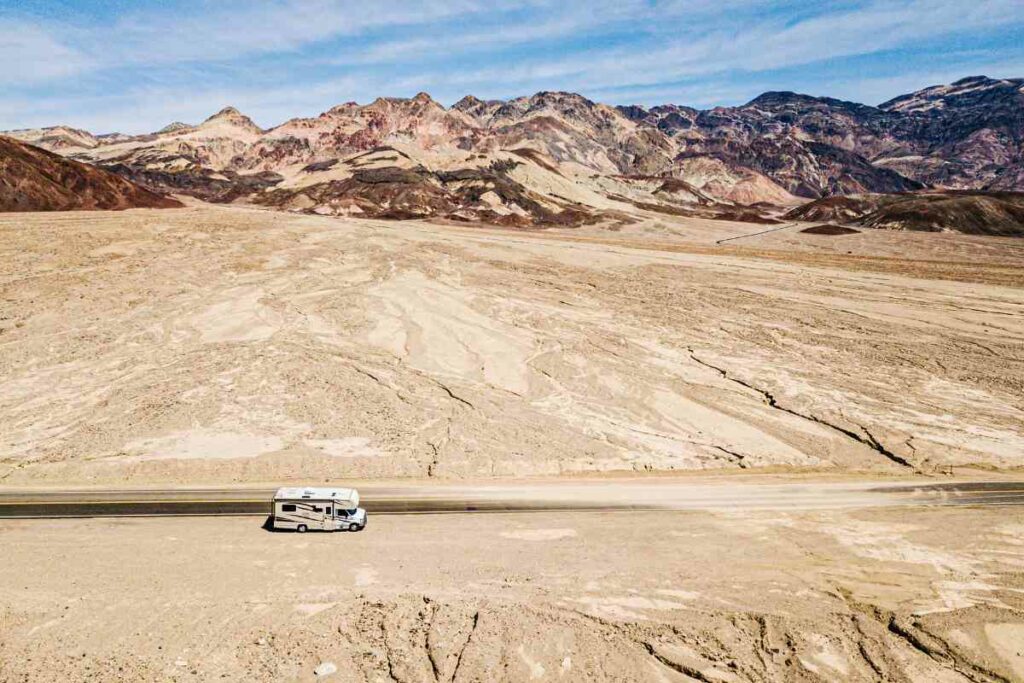
- Distance: Approximately 268 miles
- Time: Approximately 4 hours and 42 minutes
Getting to Death Valley National Park
To get started, you’ll need to head out of the Sequoia National Park onto the CA-58 E.
This road will take you through the Kern River Valley, where you will be able to enjoy the scenic views of the lush green mountains and valleys.
The road will eventually turn into CA-99 S, where you’ll be able to see the iconic windmills of the San Joaquin Valley before reaching the city of Bakersfield.
From Bakersfield, take CA-14 N, which will take you through the Mojave Desert. This road is a popular route for travelers heading to Death Valley National Park due to the picturesque landscape.
As You Drive – Watch out for the unique rock formations, vast sand dunes, and majestic Joshua Trees!
Once you’ve made it through the Mojave Desert, you’ll be on the home stretch!
Take CA-190 E, which will take you through the Panamint Valley and through the Panamint Mountains.
You’ll be able to get some great views of the valley, and the mountains will provide you with a stunning backdrop.
Finally, take CA-178 E, and you’ll be in Death Valley National Park!
Exploring Death Valley National Park
Death Valley National Park is an excellent destination for those seeking a unique and memorable experience.
It is located in California’s Mojave Desert, the hottest and driest place in North America.
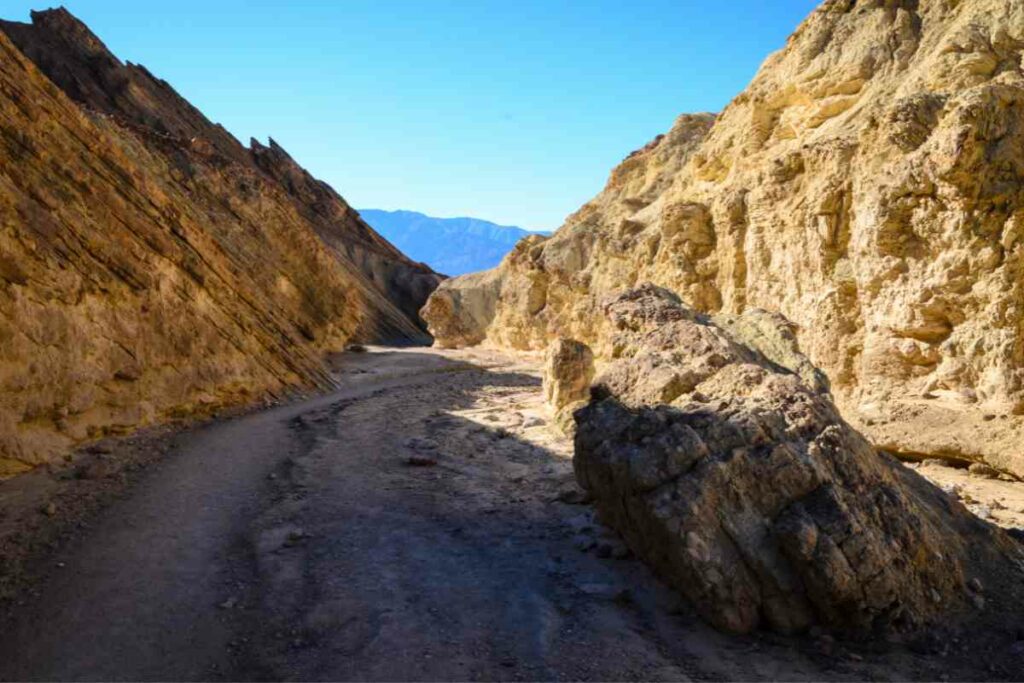
It is known for its extreme temperatures and barren landscape and is home to some of the most unusual and unique plants and animals.
Visitors can expect to see shifting sand dunes, rugged canyons and mountains, and vast stretches of desert.
There are also unique geological formations, such as the mysterious Ubehebe Crater and the Mesquite Flat Sand Dunes.
Death Valley is also home to various wildlife, including:
- coyotes
- kit foxes
- bighorn sheep
- and desert tortoises
Birdwatchers can look for various species, including golden eagles, roadrunners, and peregrine falcons.
Visitors can also expect to enjoy various activities, from hiking and camping to stargazing and photography.
Several ranger-led programs are available throughout the year, such as interpretive hikes, night sky programs, and wildflower walks.
Camping and lodging
There are nine campgrounds in Death Valley National Park, all of which are open year-round.
Campsites range from primitive backcountry sites to developed campgrounds with water, picnic tables, and restrooms.
All campsites require a fee and must be reserved in advance.
Two lodging options are available:
- the Furnace Creek Inn and Ranch
- and the Stovepipe Wells Village Hotel
The Inn provides a variety of room types, including suites and cottages.
The Hotel is more basic, with rooms, cabins, and campsites. Both properties offer restaurants, shops, and activities.
4. Death Valley National Park to Joshua Tree National Park
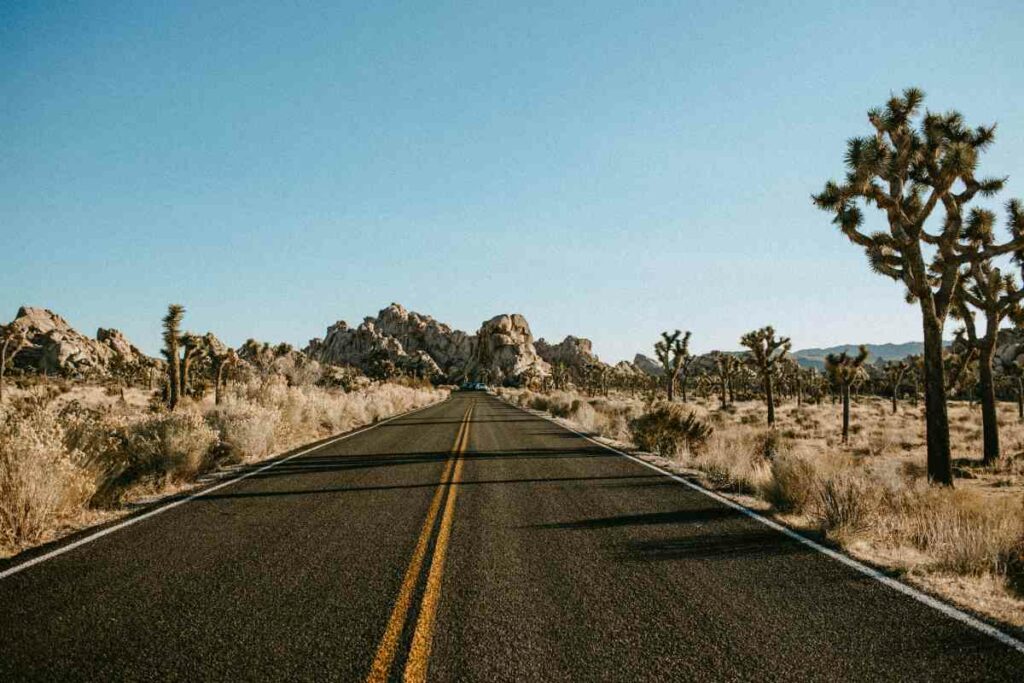
- Distance: Approximately 229 miles
- Time: Approximately 4 hr 1 min
Getting to Joshua Tree National Park
Yosemite and Joshua parks are located in two different states, but the drive between them is a straight shot down the CA-247 S.
This route is the best way to experience the picturesque of the Mojave Desert and the stark contrast between the two parks.
The first part of the journey down CA-247 S will take you through the outskirts of Death Valley National Park.
You will see stunning desert landscapes, rolling hills, and stunning rock formations here.
It’s an excellent place to spot wildlife, including:
- coyotes
- jackrabbits
- and roadrunners
As you make your way further down the road, you’ll pass through the small towns of Baker and Barstow.
Baker is a great place to stop for fuel and supplies; it is the last town before entering Joshua Tree National Park.
What to Expect? After passing through Baker, you’ll have about an hour and a half left on the road before reaching the park.
Exploring Joshua Tree National Park
Visiting Joshua Tree National Park is a fantastic experience.
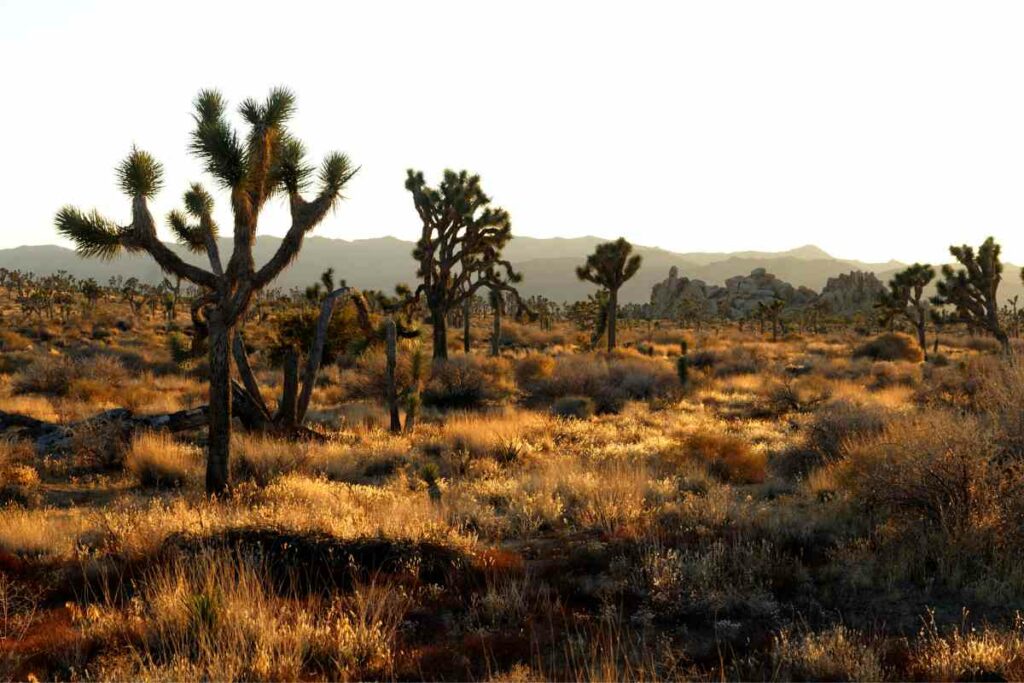
Its unique desert landscape, rich wildlife, and interesting rock formations make it a fantastic place to explore.
You may also like ?
Here’s what to expect when visiting Joshua Tree National Park:
- Rich Wildlife: There is a variety of wildlife, including coyotes, bobcats, bighorn sheep, and many species of birds. You may also spot lizards, snakes, and other creatures.
- Interesting Rock Formations: The Park contains interesting rock formations, including granite boulders and massive monzogranite outcrops. You can also find the Joshua tree’s famous monzogranite domes.
- Star Gazing: Star gazing is one thing you must do while in Joshua Tree National Park. With its night skies and minimal light pollution, it’s one of the best places for star gazing.
- Unique Geology: With a variety of interesting rock formations and landforms, you can find evidence of ancient volcanic activity, as well as evidence of ancient shorelines.
- Unique Flora and Fauna: The Park is home to various unique flora and fauna. You can find a variety of cacti, desert shrubs, Joshua Trees, and a variety of birds, reptiles, and mammals.
Camping and lodging
For those who want to stay closer to the park, a few private campgrounds are located just outside the park boundary, offering R.V. sites, cabins, and tent camping.
All campsites include picnic tables and fire rings; most also provide potable water and restrooms.
Some campgrounds only operate on a first-come, first-served basis, while others can be scheduled ahead of time.
Additionally, over 100 “backcountry” sites in the park are accessible only by foot and offer minimal amenities.
The park also offers lodging at the 29 Palms Inn, located just outside the park boundaries in Twentynine Palms.
This historic Inn provides a range of accommodations, from rustic cabins to plush suites.
There are also several privately-owned lodging options in the surrounding area, including hotels, motels, and vacation rentals.
5. Joshua Tree National Park to Hoover Dam
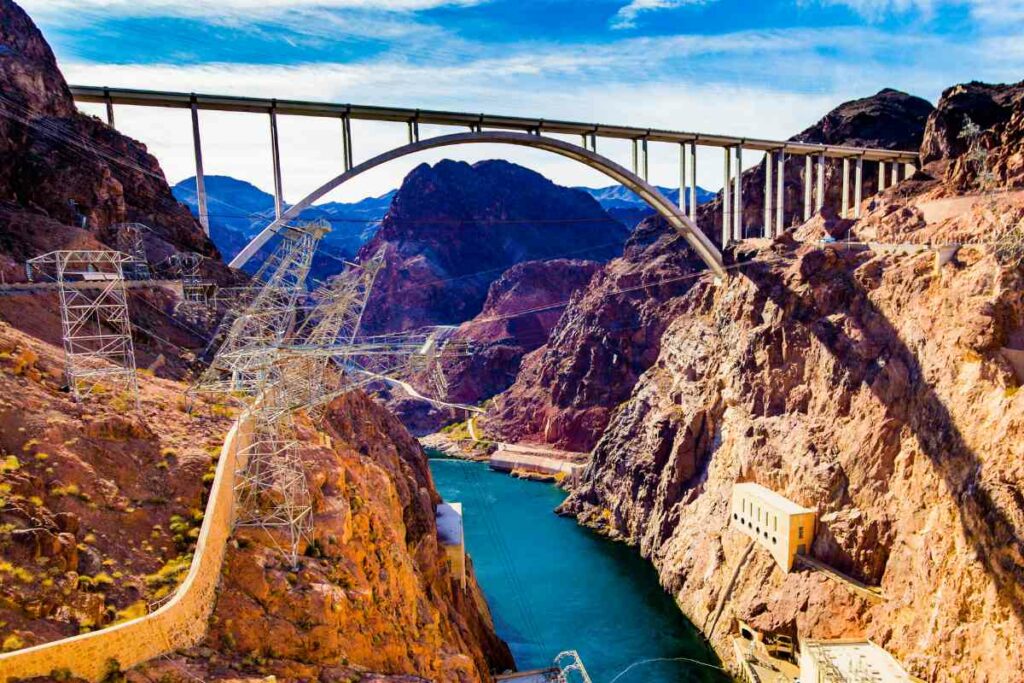
- Distance: Approximately 209 miles
- Time: Approximately 3 hr 19 min
Getting to Hoover Dam
To get to Hoover Dam from Joshua Tree National Park, you will need to take US-95 North.
- You will start off heading west from Joshua Tree National Park on CA-62, then take I-10 West towards Indio.
- Follow I-10 West for about 65 miles until you reach AZ-95, where you will take a left.
- Follow AZ-95 for around 62 miles until you reach US-95 North, then take US-95 North for about 109 miles until you reach Hoover Dam.
Exploring Hoover Dam
Hoover Dam is one of the most iconic and impressive feats of engineering in the United States.
The dam is located on the Colorado River between Nevada and Arizona. It was constructed in the 1930s and stands 726 feet tall.
The dam is the largest reservoir in the country and provides power and water to millions of people in the southwestern United States.
The dam is an awe-inspiring structure, and the views from the top are truly amazing.
From the top, you can see the miles of desert landscape, the winding Colorado River, and the surrounding mountains.
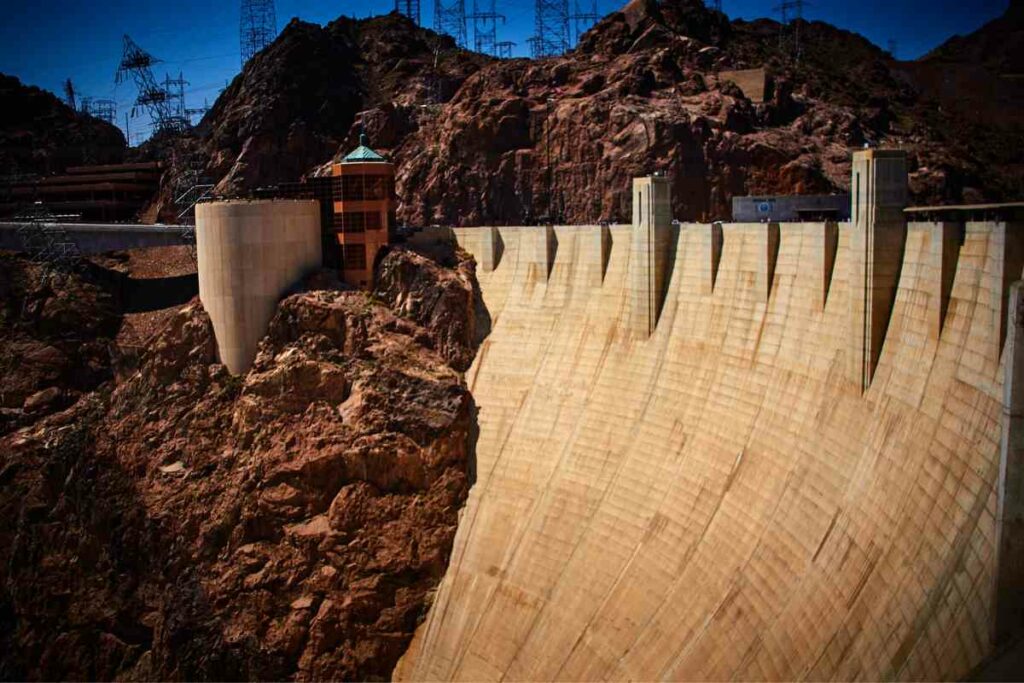
The dam also has a visitor’s center where you may learn about the history and importance of the dam, as well as take a tour of the power plant.
Tours are fascinating, as they provide a unique perspective on the dam’s inner workings.
On the tour, you can explore the turbines and generators and learn about the dam’s function in controlling water flow in the area.
It is also an educational experience, as you can learn about the history and importance of the dam.
Additionally – The dam area is home to various recreational activities, including hiking, camping, and boating. There are also plenty of places to stay near the dam, such as hotels and resorts.
If you want to experience the awe-inspiring beauty of Hoover Dam, there is no better way than to experience it in person.
It is an experience that you will never forget.
Camping and lodging
Camping and lodging options near Hoover Dam are limited.
The nearest campgrounds and hotels are located in the towns of Boulder City and Henderson, both of which are several miles away.
The Boulder Basin Campground is situated in the Lake Mead National Recreation Area and is the closest camping option to Hoover Dam.
The campground is open year-round and offers full hookup sites, tent camping, and R.V. sites with a maximum of 10 people per site.
The Cottonwood Cove Campground is situated in the Lake Mead National Recreation Area and is about 25 miles from the dam.
The campground offers R.V. sites with a maximum of 10 people per site and tent camping.
For those looking for more traditional lodging, there are several hotels and motels in Boulder City, Henderson, and Las Vegas.
The closest hotels to the dam are located in Boulder City and range from budget to luxury accommodations.
6. Hoover Dam to Grand Canyon National Park
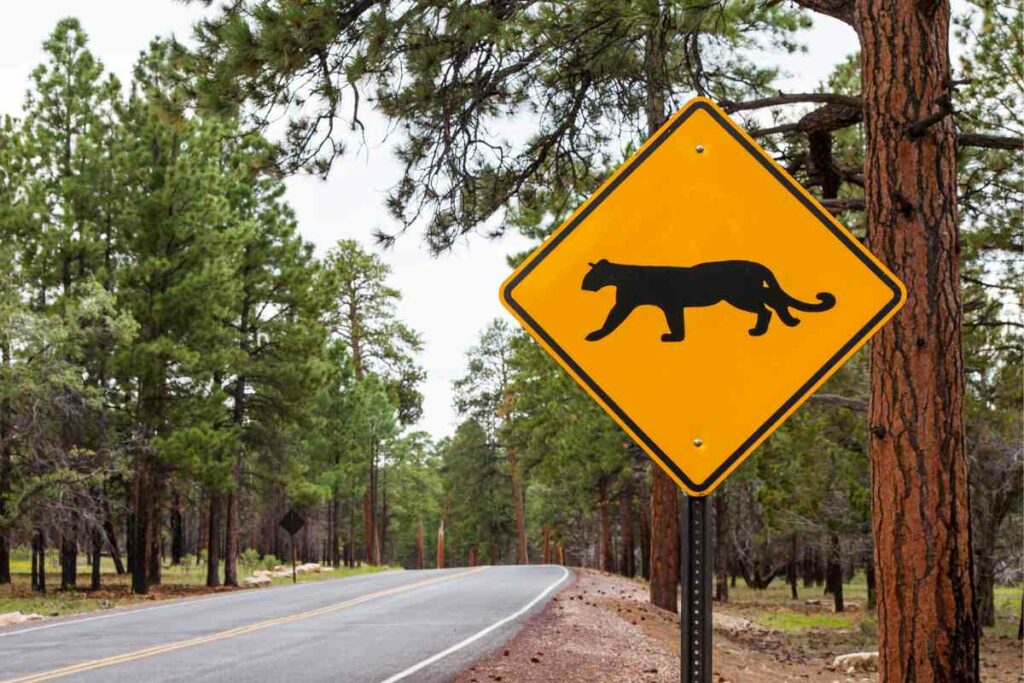
- Distance: Approximately 243 miles
- Time: Approximately 3 hr 43 min
Getting to Grand Canyon National Park
In order to get to Grand Canyon National Park from Hoover Dam, you need to take US-93 S and I-40 E.
- Start by taking US-93 S out of Hoover Dam.
- Make sure to stay on the US-93 S for about 77 miles until you reach Kingman, Arizona.
- At Kingman, take I-40 E and continue for about 223 miles.
- When you reach Flagstaff, AZ, take the US-180 E exit and stay on US-180 E for about 65 miles.
You will then reach the entrance to Grand Canyon National Park. Enjoy your time exploring the majestic canyon and all it offers.
Exploring Grand Canyon National Park
The Grand Canyon is located in northern Arizona and houses one of the most scenic views on earth.
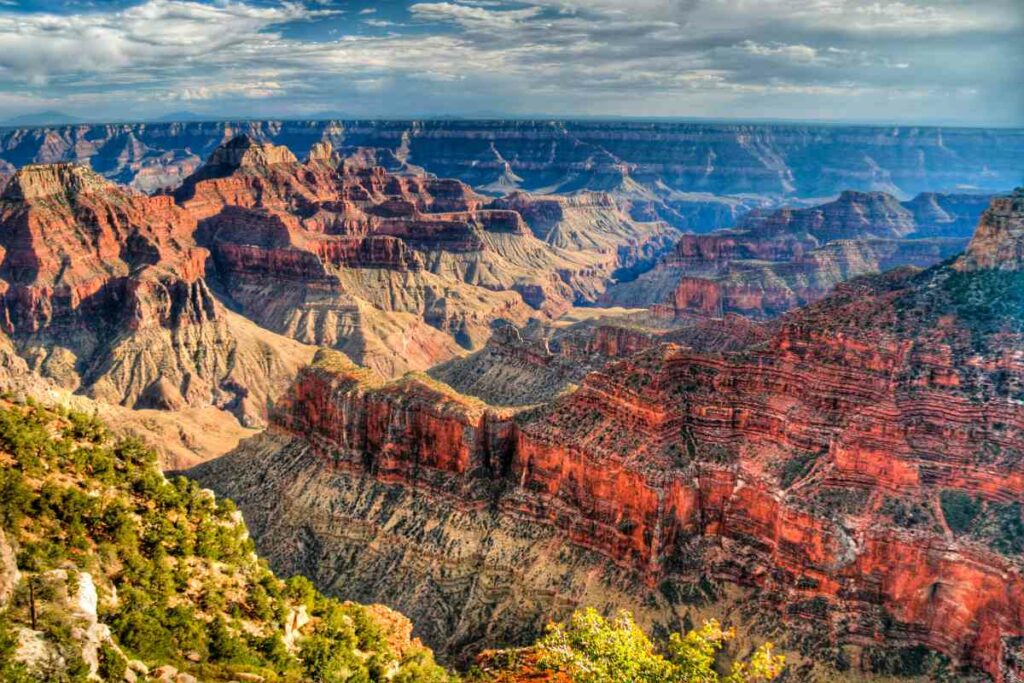
There are numerous trails, viewpoints, and overlooks throughout the park that offer stunning views of the canyon.
The Grand Canyon also boasts some of the best river rafting and kayaking opportunities in the U.S.
In addition to the canyon itself, The Grand Canyon National Park is also home to a variety of wildlife.
You may also like ?
Common animals you can see include bighorn sheep, mule deer, elk, cougars, and more.
The park is also a recognized dark sky park, allowing visitors to enjoy the amazing night sky.
Furthermore, it is also home to a variety of cultural attractions.
The historic Grand Canyon Village is great to explore, with its numerous museums, galleries, and other cultural attractions.
For Example – There are also various Native American tribes in the region, with numerous cultural events and activities taking place throughout the year.
Camping and lodging
Camping is allowed at the North and South Rims of the Grand Canyon where various camping sites and amenities available.
The park also allows backcountry camping, although permission is required. Campers can find a range of amenities, from R.V. hookups to more primitive camping sites.
Lodging within the park includes the:
- historic El Tovar Hotel
- Maswik Lodge
- Bright Angel Lodge
- and Phantom Ranch
Those looking for lodging outside the park can find various hotels, motels, and resorts in the nearby town of Tusayan.
Final Thoughts
No matter which route you take from Yosemite to the Grand Canyon, you will see some of the most picturesque scenery in the United States.
From the lush forests of Yosemite to the breathtaking rock formations of the Grand Canyon, this road trip provides a unique opportunity to appreciate the beauty of the American Southwest.
Along the way, you’ll have the opportunity to tour some of the region’s best attractions, sample local cuisine, and experience amazing outdoor activities.
With its stunning scenery, vibrant culture, and countless adventures, it’s no surprise that this road trip is one of the most popular in the USA.
So, if you’re looking for a memorable trip, then it’s time to plan your Yosemite to Grand Canyon road trip.

